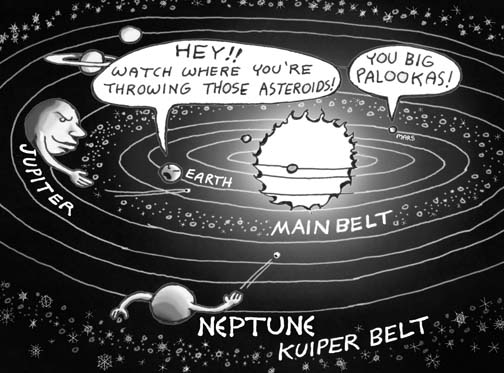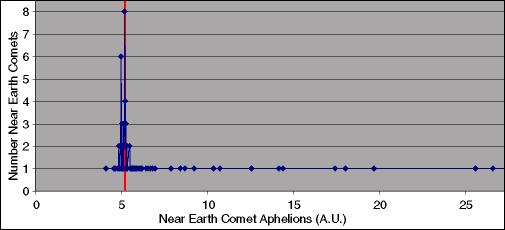The possibility of volatile rich NEOs
 |
|
-
Near Earth Objects (NEOs) typically cross the orbits of several
planets. Their orbits are easily altered by these planets. A
close approach to a planet can send a NEO into the sun, out of the solar
system or on a collision course with the planet. So NEOs are thought to be
short lived. If the present body of NEOs are recent arrivals, where do
they come from? It's believed they come from the Main Asteroid Belt or
the Kuiper Belt where gravitational influences of Jupiter and other gas
giants send them our way.-
If NEOs are recent arrivals from colder places, they have a greater
likelihood of being volatile rich. Here is a list of links suggesting
the existence of volatile rich NEOs-
Asteroid 1979 VA/Comet Wilson Harrington.
Comet Wilson Harrington was lost shortly after its discovery in 1949.
In 1979 the asteroid 1979 VA was discovered. Later it was discovered
that 1979 VA and Comet Wilson Harrington are the same object. The
asteroid 1979 VA is a comet that's stopped outgassing. This suggests
that other asteroids may also be extinct comets.David Brin's model of cometary evolution suggests the possibility of extinct comets whose insulating exteriors protect an icey core.
-
-
Main Belt Asteroid Comets. Four main belt asteroids have been discovered that display outgassing
typical of comets. This suggests some of the main belt asteroids have
icey interiors.Themis Ice Layer. A thin layer of ice and organic molecules was found on 24 Themis. This layer of ice was unexpected at this asteroid that orbits at about 3 A.U. from the sun. -
Trojan Ice Balls. Recent evidence indicates Jupiter's Trojans may be captured Kuiper Belt Objects.-
|
 |
| NECs with 5.2 A.U. Aphelions.
This is the JPL Near Earth Comets orbital elements page. Choose "Sort
by Aphelion Distance (Q)" and "200 rows per page" and it can be seen a
disproportionate number have 5.2 A.U. aphelions. The Trojan asteroids
lie at regions 5.2 A.U. from the sun. This at least suggests we're
receiving objects from Jupiter's Trojan regions. When I checked in
October, 2007 there where 144 known Near Earth Comets with aphelions
ranging from 4.1 to 64.9 A.U. Of these, 48 have aphelions between
5.1 and 5.3 A.U. (see graphic above). -
Icey Meteorites.
This page talks about the discovery of icey meteorites in China.
Although it is common to find meteorites with hydrated clays, icey
meteorite finds are rare. Such meteorites would be hard to find as they
would melt soon after impact. This PDF
discusses reasons to suspect icey meteorites reach the earth and why
such meteorites would only rarely be found. The discovery of the
Chinese icey meteorites suggests icey NEOs exist.-
Why would volatile rich NEOs be
valuable? Of course water is needed to sustain life. In space water
also makes an excellent radiation shield. Using solar or nuclear
energy, its components can be separated and used to make rocket fuel
and reaction mass. Other volatiles containing CHON would be helpful for
maintaining habitats. An NEO with an icey interior may be exploitable by small unmanned spacecraft known as Kuck Mosquitoes.
-
|
| The possibility of metal rich NEOs - Iron Meteorites.
Iron meteorites are thought to come from the cores of large asteroids
that have been shattered. It's believed they're similar in composition
to Earth's outer core. So these would be metal ores far richer than
those typically found on planetary crusts. Meteoritic metal
is mostly iron with 8% nickel and substantial traces of precious
metals. Planetary scientist John S. Lewis has estimated an average
sized metallic asteroid would contain more iron, nickel and platinum
group metals than have been mined in all of human history.
|
| - Railroad Towns & other space stuff |